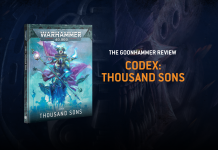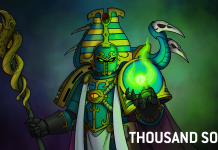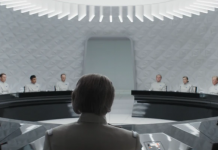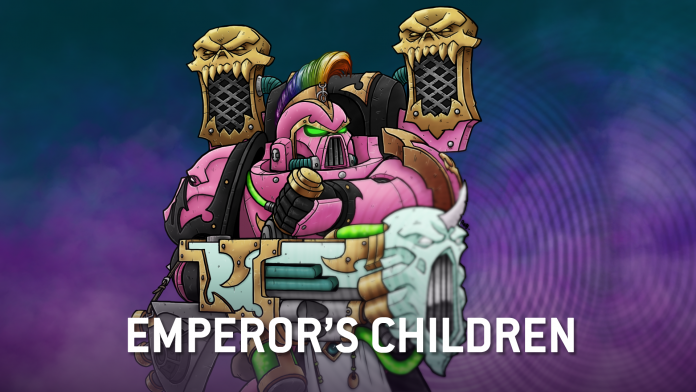In our Detachment Focus series we take a deep dive into an army’s Detachments, covering what’s in them, how they play, and how they’ll fit into the broader meta and your games. In this Detachment Focus we’re looking at the Mercurial Host from the Emperor’s Children.
The Mercurial Host is more or less going to come across as the “default” Detachment for the Emperor’s Children, giving you a very broad (but useful) Detachment ability supported by a series of Enhancements and Stratagems which are broadly useful.

Detachment Overview
If the Emperor’s Children had an Index Detachment, this probably would have been it. The Mercurial Host offers a wide variety of abilities and buffs that don’t push you into one specific unit or build and give you a good toolbox to work with. Most of what’s here is based on movement and defense, letting you play cagey and move around the board scoring, keeping your units alive as they close the gap and eviscerate enemy units. The Detachment comes across as boring but it’s offering some powerful movement tech.
The Video Version
If you’d rather watch than read about this Detachment, we’ve got you covered with the video version here:
Detachment Rule: Quicksilver Grace
You can re-roll Advance rolls for Emperor’s Children units in your army.
This seems really boring and well, it kind of is. What it does is combo with the army’s Thrill Seekers rule to make your Advances (and shoot/charge after) much more reliable, ensuring that any time you score a 1 or a 2, you’re able to attempt a bigger roll.
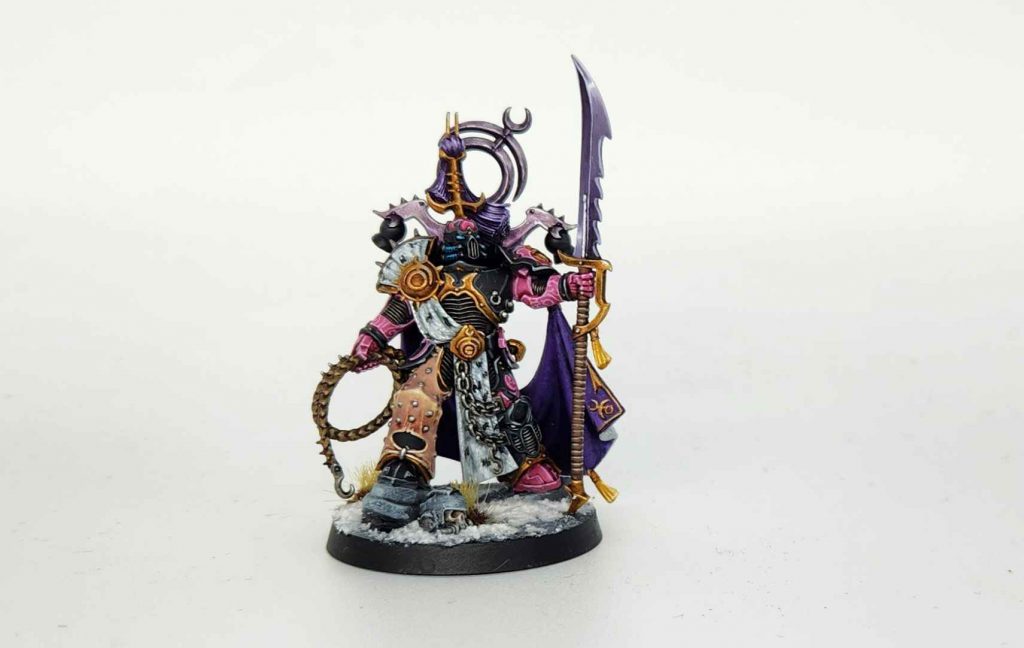
Enhancements
These are pretty open in who they can go on, and they tend to be pretty broad in their application. That said, you only have three leader options, so most of these want to go on a Lord Kakophonist.
- Steeped in Suffering – Each time a model in the bearer’s unit attacks an enemy below Starting Strength, they get +1 to hit, and +1 to wound if their target is below Half Strength. Noise Marines really want something like this to be able to push through damage against tougher targets, where you can attempt the one-two punch of lobbing a grenade at a target to soften it, then coming in with BS2+ shots. You can combine this with a Grenades unit to lob a grenade at some target you plan to shoot at to chip off a wound or two to activate the +1 to hit, then light them up with noise marines.
- Intoxicating Musk – Each time a melee attack targets the bearer’s unit, if the Strength of that attack is bigger than your unit’s Toughness, they get -1 to wound. This is a solid durability buff, and again something you want on either Noise Marines or Terminators.
- Tactical Perfection – After both players have deployed, you can redeploy up to two units from your army, and if you like, put them into reserves. This is always a solid ability to have, and great when you consider the Infiltrators and Scouts 6” abilities on Tormentors and Infractors.
- Loathsome Dexterity – Each time the bearer’s unit makes a Normal, Advance, or Fall Back move, it can move through enemy models, moving within Engagement Range, and automatically passing any Desperate Escape tests. This is a pretty narrow ability, especially given the units it can go on, and is likely to be the last Enhancement you take from this set.
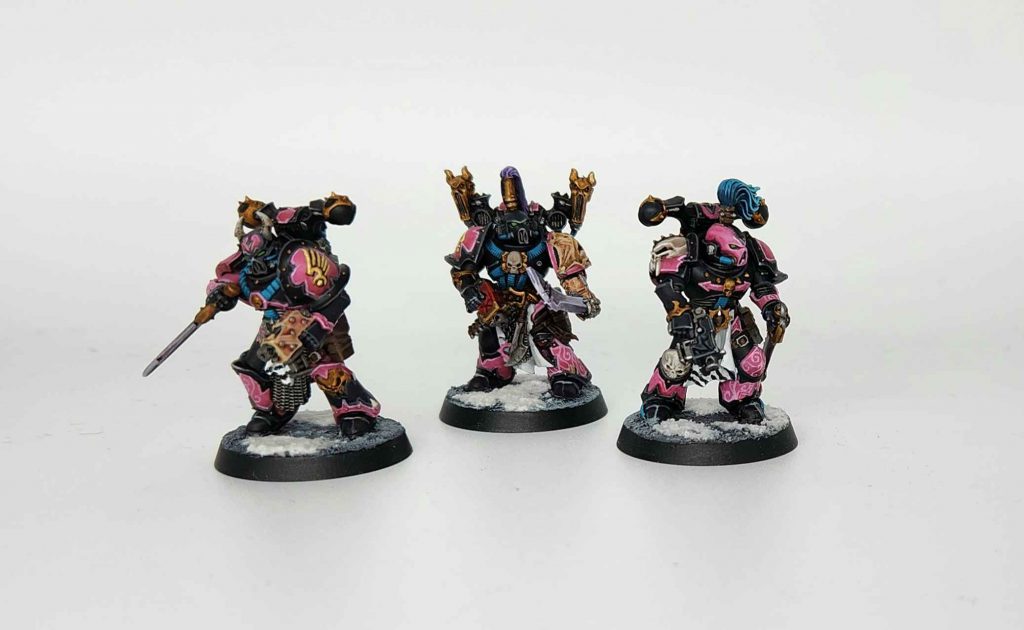
Stratagems
The Stratagems here are mostly defensive and utility pieces, helping you either move around the table or avoid incoming damage. There’s only one offensive boost in the bunch, and it’s not a particularly strong one.
- Violent Excess (Battle Tactic, 1 CP) – Used in the Fight phase to give one of your units SUSTAINED HITS 1 on their melee attacks. This is a fine output boost for 1 CP, but you already have ways to get Sustained Hits on a number of units, which may make this redundant.
- Combat Stimms (Battle Tactic, 2 CP) – Used in the Fight phase after an enemy unit picks targets. One of your targeted Emperor’s Children Infantry units gets -1 to be wounded for the phase. This is very good, though you’d like to see it be usable on Fulgrim or a Maulerfiend. Again, particularly solid on T5 units like Terminators, Flawless Blades, and Noise Marines.
- Honour the Prince (Battle Tactic, 1 CP) – Used in your Movement phase on an Infantry unit. That unit can auto-advance 6”. This is a solid way to help guarantee a big advance-and-charge turn, letting you drop 13”-14” of movement before your charge attempt.
- Dark Vigour (Strategic Ploy, 1 CP) –Used in your opponent’s Movement phase after they build a Normal, Advance, or Fall Back move within 9” of one of your non-Beast/non-Vehicle units. That unit can make a Normal move of up to 6”. These kinds of reactive moves are always useful, and the non-Beast restriction doesn’t matter that much given Chaos Spawn already have one built-in.
- Capricious Reactions (Battle Tactic, 1 CP) – Used in your opponent’s Shooting phase, after they pick targets. One of your targeted units is -1 to be hit. This is another solid defensive buff, and helpful if you want to avoid incoming shooting. Could be useful with Fulgrim against armies that regularly proc +1 to hit – such as T’au or Votann – where you can combine it with his ability to put them on -2.
- Cruel Raiders (Strategic Ploy, 1 CP) – Used at the end of your opponent’s Fight phase on a unit in your army that’s wholly within 9” of a battlefield edge and outside 3” of any enemy units. You can put that unit back into reserves. This is pretty restrictive, but any ability to go back into reserves is worth having, and this works just fine on a unit of Chaos Spawn or Tormentors, who can then pick up and easily drop back down the following turn to help score things like Behind Enemy Lines or Engage on All Fronts.
Playing This Detachment
This Detachment is all about adding utility to your units, making their Advances more reliable and giving you some decent ways to shrug off incoming damage and move around the table. It’s pretty straightforward in most respects – a lot of buffs here seem geared towards heavier units like Noise Marines, Flawless Blades, and Terminators, where you can stack things like -1 to be hit or wounded on top of higher toughness values. What you have here is just a solid toolkit for getting more out of your units, though it’s worth noting that Combat Stimms at 2 CP make it a bit pricey, so you may want to have an icon or two in your list to help generate the occasional extra CP.
In games, your plan will be to play cagey, picking and choosing your spots against opponents as you play keep away until it’s time to strike, scoring secondary VP and staying ahead with cheaper action units like Spawn and Tormentors.
Strengths
- Great Movement. You’ve got the in-built re-rolls to your advances, plus an auto-advance 6”, a reactive move, and the ability to come off the table if you’re close to the board edge. That’s a very solid suite of movement abilities to help stay out of trouble and keep scoring.
- Solid Defensive Buffs. You have two different ways to get -1 to be wounded, plus a -1 to be hit, giving you multiple ways to dodge incoming damage on your elite units.
- Lots of Utility. Aside from the INFANTRY restrictions, very little in this Detachment is gated around a specific unit, freeing you up to build however you like.
Weaknesses
- Few Offensive Buffs. Your offensive buffs are limited to a single SUSTAINED HITS Stratagem and an Enhancement, which isn’t ideal.
- Mediocre Detachment Ability. Re-rolling Advance rolls is fine, but you aren’t always going to be Advancing, and even if you are, you probably won’t need to re-roll more than half of your Advance rolls. This one’s useful but there’s nothing exciting or particularly powerful about it.
A Sample List
As the broadest Detachment for Emperor’s Children, you have a lot of options with the Mercurial Host. That’s a double-edged sword, in that you can absolutely build anything, but you won’t get the raw power that comes from more unit-specific Detachment buffs. Here’s a sample list option that takes a wide variety of units in the army into consideration.
Sample List - Click to Expand
This is a grab bag of stuff but you’ve got something for everything. The Maulerfiends give you some nice, fast distractions to either keep the heat off Fulgrim or punish an opponent for committing to him early, and at their updated points cost they’re cheap enough you want them in most lists. The Noise Marines here give you your only fire support, and you’ll want to pair them with a unit that can throw grenades ahead of them so you can get the benefit from the Lord Kakophonist’s Steeped in Suffering Enhancement. The Tormentors are your objective holders and action-doers, and you have two Rhinos to cart around Noise Marines, Infractors, and characters.
Final Thoughts
The Mercurial Host Detachment is tough to write about, in part because it’s the kind of unexciting utility Detachment that savvy players will use to dictate the flow of the battle. Movement is life in Warhammer 40k, and in that sense Mercurial Host armies are going to be full of life. The big question will be whether they hit as hard as they need to when they finally do get into combat.
Have any questions or feedback? Drop us a note in the comments below or email us at contact@goonhammer.com. Want articles like this linked in your inbox every Monday morning? Sign up for our newsletter. And don’t forget that you can support us on Patreon for backer rewards like early video content, Administratum access, an ad-free experience on our website and more.

